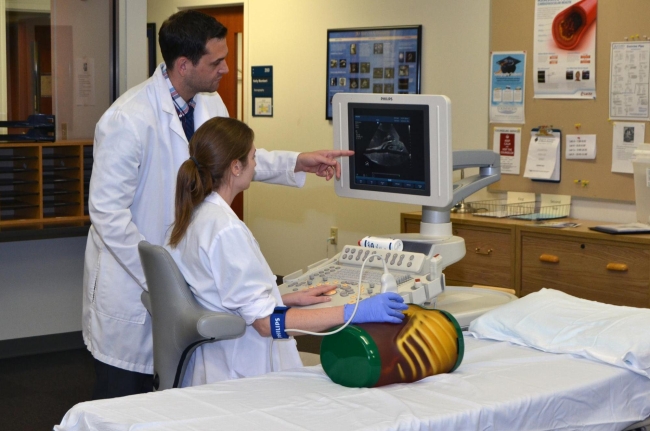You have /5 articles left.
Sign up for a free account or log in.

A student in a sonography lab practices on a model.
Adventist U of Health Sciences
Students aren’t always model patients.
Valencia College's president banned the use of transvaginal probes in its sonography program Tuesday after two students alleged in a lawsuit that they were forced to be probed in fear of retaliation. And despite claims from the college that similar practices are typical across the country, officials at other sonography and nursing programs said the invasive, student-on-student teaching techniques are not the norm and are more likely to be left to professionals in clinics.
The two students claim they were told the probing was not a required part of Valencia’s sonography program, but instructors at the college told them they would have to leave the program if they did not agree to the probing. Valencia’s president, Sanford Shugart, cited the resulting controversy in his decision to ban the practice Tuesday.
"The use of volunteers -- including fellow students -- for medical sonography training is a nationally accepted practice. Valencia’s sonography program has upheld the highest standards with respect to ultrasound scanning for educational purposes, including voluntary participation and professional supervision by faculty in a controlled laboratory setting," officials at the college said in a statement last week, before the decision to end the practice was made. "Nonetheless, we continue to review this practice and others to ensure that they are effective and appropriate for the learning environment."
Kathleen Megivern, executive director of the Commission on Accreditation of Allied Health Education Programs, the accrediting body for health science programs including those at Valencia, said it was typical for students in sonography programs to practice using ultrasound tools, or “scanning,” on each other, but described the number of programs that actually have students practice invasive procedures on each other as “increasingly small and bound to become even smaller.”
She said Valencia's program had been reviewed as recently as 2011 but that no red flags were raised at the time about its practices. The college is in the process of reapplying for accreditation and has already submitted its self-study to CAAHEP.
Students training to become sonographers often begin earning their associate degrees with lectures, followed by laboratory hours. More than half of their credits come from hours spent in clinics, observing and performing sonograms on patients.
“Students practicing on students is a widespread, common and acceptable practice in allied health professions, even in nursing and medicine, but not the invasive stuff,” Megivern said. “If any of what is being alleged is true, then it’s very strange, very strange to me.”
Cynthia Reber-Bonhall, the program coordinator for Orange Coast College’s diagnostic medical sonography program, said her students will only scan noninvasive parts of other students, limiting contact to the legs, arms, neck and abdomen.
She said invasive procedures are practiced on phantoms, or models, of different parts of the body, but students won’t perform any of those practices on actual patients until they are in a clinic under the supervision of a professional.
“It’s a standard in the community, a lot of the schools use the students as patients,” Reber-Bonhall said. “We use students, but nothing is invasive.”
And at nursing programs, student-on-student learning is generally limited to practicing basic skills, like head-to-toe physical assessments and learning how to listen to a heartbeat or take a patient’s blood pressure.
Judy Beal, dean of the Simmons School of Nursing and Health Sciences at Simmons College, said that while students in the nursing program do practice those fundamentals on one another, students are typically introduced to clinical skills on high-fidelity manikins. (Note: A manikin, related to a mannequin, is a life-sized anatomical model used in education.)
She said the manikins can be used to replicate a number of scenarios students might not have an opportunity to learn in clinical but that are still important to understand. Simmons’s models can replicate medical scenarios ranging from cardiac arrest to childbirth.
“We simulate key scenarios with high-fidelity manekins to make sure that they are prepared for this in the real world,” Beal said, adding that simulation is more of a supplement to the clinical skills taught on patients than a replacement.
At the University of California at Irvine, undergraduate nursing students who are new to the profession practice tasks like placing intravenous lines and performing injections on manikins, but practicing nurses returning to school for a graduate degree are able to utilize what are known as standardized patients, a group of individuals hired by the university for medical and nursing students to work with before moving on to actual patients.
Susanne Phillips, a clinical professor of nursing at Irvine, said the standardized patients are able to give students performing exams immediate feedback, acting as a transition point between manikin and clinical experience.
“They can give them real-time feedback where the student isn’t worried that this is a real patient and ‘I might miss something,’” Phillips said.
Phillips said standardized patients are a “relatively new” addition to health education, becoming more common over the past few decades, and in the past students would be asked to bring in someone to perform physical assessments on or to practice the tests on other students.
Bobbie Salveson, director of the Center for Excellence in Nursing Education Learning Lab at the University of Washington’s School of Nursing, said her students will sometimes practice a limited number of invasive skills -- like injections -- on each other, but never without student permission and always under the supervision of an instructor.
She said before students are allowed to practice on a person, including standardized patients, they must practice at least twice on manikins and be approved by an instructor to continue.
“There are some things they do on each other, but it’s more to get the feel, like what it feels like to have tape taken off of your skin,” Salveson said. “They practice a huge number of skills, but not necessarily on each other.”








